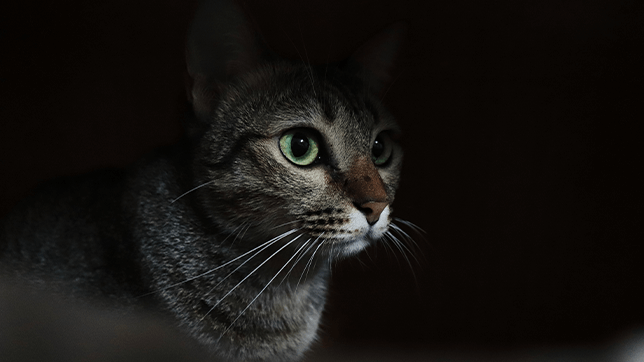14th October 2022
Can cats see in the dark?

Cats might have been domesticated approximately 9,000 years ago, but there’s still a lot we don’t know about our feline friends and how well they can see is still one of those mysteries. Since they’re most active at dawn and dusk (and the darker hours in between), people often wonder if their cats can see in the dark.
We’re here to help bust some myths and answer your questions about your feline friend’s amazing sight.
How do cats see in the dark?
Our feline friends are able to see better in the fading light than we can thanks to the their corneas and pupils, which are much larger than ours, and allow in more light.
However, although their sight is much more advanced than ours, cats are not able to see in complete darkness.
Are cats nocturnal?
As the entire house starts to wind down ready for the looming bedtime, your cat is probably just waking up from their daytime slumber. While nocturnal animals are active at night (cats have the same almond-shaped pupils as these nighttime adventurers), our feline friends are actually crepuscular, which means they are most active at dawn and dusk.
Are cats scared of the dark?
Every cat is different, with some fearing nothing at all and others fearing everything, so, how do cats get on in the dark? Well, it all depends on whatever they might have experienced previously on their nighttime adventures, as this could impact their confidence while exploring in the evening darkness.
Crepuscular animals like cats tend to head out during the twilight hours as the fading light means they can still see, but it is dark enough to reduce the chances of them being seen by potential predators and their prey.
If your cat shows signs of anxiety, including dilated pupils, sweaty paws, crying and an increased heartbeat when it comes to the darker times of day, you might want to consider keeping a light on for them.
Other interesting facts about a cat’s eyesight
Here are some fun facts all about your feline’s eyes to finish:
- They can’t distinguish between reds and greens.
- They can detect objects moving at four millimetres per second.
- Cats have better peripheral vision than we do.
- Cats have three eyelids.
So, while our cat's eyes are not hugely different from our own, how they use them alongside their other senses means they stay safe as they explore the dusky hours of the day.
Looking for more cat advice?
We’ve written some handy cat advice guides, to help you unlock the secrets of your mysterious moggy.
Need cat insurance?
Cat insurance can help cover the cost of veterinary treatment if your cat gets injured or falls ill.
We know pets
Our pets are part of the family. To achieve our vision of a better future for pets everywhere, we work with our partners, vets, and other veterinary professionals who are pioneering the latest advancements in animal care. Our campaigns, articles, and events are crafted to support, educate, and celebrate pet owners, while our policies are designed to provide peace of mind at an affordable price.
Yet our policies don’t just protect against the unexpected – they have purpose, too.
Since we were founded over 25 years ago, we've provided industry-leading policies that protect the nation’s pets, while also making a difference to animal welfare and our planet. Thanks to you, our policyholders, we've donated over £9 million to more than 830 animal welfare charities and conservancies, helping to support vulnerable pets and wildlife around the world.
We’re proud to be wildly different. Are you?
